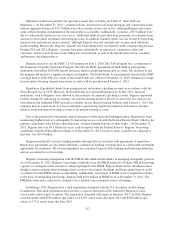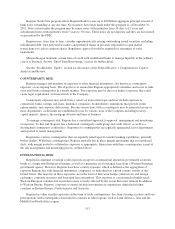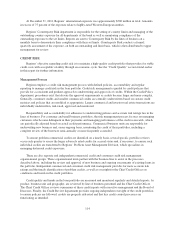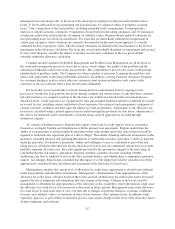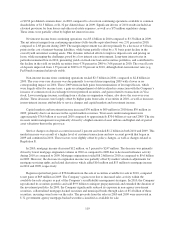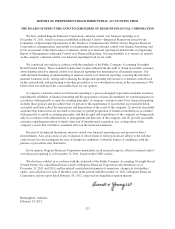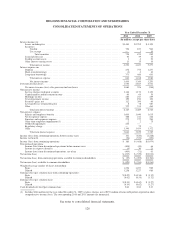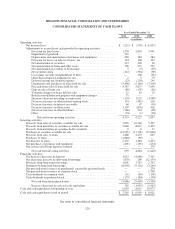Regions Bank 2011 Annual Report Download - page 143
Download and view the complete annual report
Please find page 143 of the 2011 Regions Bank annual report below. You can navigate through the pages in the report by either clicking on the pages listed below, or by using the keyword search tool below to find specific information within the annual report.or $0.56 per diluted common share, in 2010 compared to a loss from continuing operations available to common
shareholders of $1.3 billion, or $1.32 per diluted share, in 2009. Significant drivers of 2010 results included an
elevated provision for loan losses and other real estate expenses, as well as a $75 million regulatory charge.
These items were partially offset by higher net interest income.
Net interest income from continuing operations was $3.4 billion in 2010 compared to $3.3 billion in 2009.
The net interest margin from continuing operations (fully-taxable equivalent basis) was 2.91 percent in 2010,
compared to 2.68 percent during 2009. The margin improvement was driven primarily by a decrease of 61 basis
points in the cost of interest-bearing liabilities, while being partially offset by a 31 basis point decline in the
overall yield on interest earning assets. This dynamic reflected efforts to improve deposit costs and pricing on
loans, while managing the challenges posed by a low interest rate environment. Long-term interest rates in
particular remained low in 2010, pressuring yields on fixed-rate loan and securities portfolios, and contributed to
the decline in the yield on taxable securities from 4.78 percent in 2009 to 3.66 percent in 2010. The overall costs
of deposits improved from 1.35 percent in 2009 to 0.78 percent in 2010, although short-term interest rates (e.g.
Fed Funds) remained relatively stable.
Non-interest income from continuing operations totaled $2.5 billion in 2010, compared to $2.8 billion in
2009. The year-over-year decrease was due primarily to several items impacting 2009 with a lower or no
corresponding impact on 2010. These 2009 items include gains from terminations of leveraged leases, which
were largely offset by income taxes, a gain on extinguishment of debt realized in connection with the Company’s
issuance of common stock in exchange for trust preferred securities, and gains related to transactions in Visa
stock. Lower mortgage income, resulting from a decline in origination volume, also drove the year-over-year
decline. These decreases were largely offset by higher gains from sales of securities in 2010, as well as increases
in non-interest income attributable to service charges and capital markets and investment income.
Capital markets and investment income increased $30 million to $69 million in 2010 from $39 million in
2009, primarily due to an increase in the capital markets revenues. Trust assets under management were
approximately $76.6 billion at year-end 2010 compared to approximately $70.0 billion at year-end 2009. The rise
in assets under management was primarily driven by a higher amount of asset inflows and higher end-of-period
asset valuations than in the prior year.
Service charges on deposit accounts increased 2 percent and totaled $1.2 billion in both 2010 and 2009. This
modest increase was a result of a higher level of customer transactions and new account growth that began in
2009 and continued in 2010. These factors were slightly offset by policy changes, as well as changes related to
Regulation E.
In 2010, mortgage income decreased $12 million, or 5 percent to $247 million. The decrease was primarily
driven by lower mortgage origination volume in 2010 as compared to 2009 due to decreased refinance activity
during 2010 as compared to 2009. Mortgage originations totaled $8.2 billion in 2010 as compared to $9.6 billion
in 2009. However, the decrease in origination income was partially offset by market valuation adjustments for
mortgage servicing rights and related derivatives which added $16 million and $13 million to mortgage income
in 2010 and 2009, respectively.
Regions reported net gains of $394 million from the sale of securities available for sale in 2010, compared
to net gains of $69 million in 2009. The Company’s gains were due to increased sales activity within the
available-for-sale category as part of the Company’s asset/liability management strategies. In 2010, the Company
repositioned its securities portfolio and sold $9.9 billion to mitigate prepayment risk and extended the duration of
the investment portfolio. In 2009, the Company significantly reduced its exposure in non-agency investment
securities, collateralized mortgage-backed securities and municipal bonds through sales of $5.4 billion of these
securities, incurring some losses on the sales. The proceeds from the sales in 2010 and 2009 were reinvested in
U.S. government agency mortgage-backed securities classified as available for sale.
119





